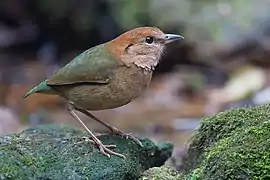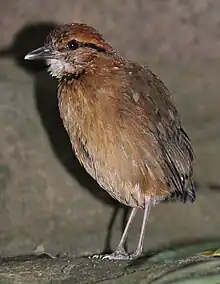Hydrornis
Hydrornis is a genus of pitta in the family Pittidae. The genus contains thirteen species, found in South-east Asia. The genus was formerly merged with the genus Pitta, but a 2006 study split the family into three genera.
| Hydrornis | |
|---|---|
 | |
| Male Javan banded pitta, Hydrornis guajanus | |
| Scientific classification | |
| Domain: | Eukaryota |
| Kingdom: | Animalia |
| Phylum: | Chordata |
| Clade: | Dinosauria |
| Class: | Aves |
| Order: | Passeriformes |
| Family: | Pittidae |
| Genus: | Hydrornis Blyth, 1843 |
| Species | |
|
See text. | |
Taxonomy
The pittas were at one time all usually placed in the genus Pitta, the only genus in the family Pittidae, but when a 2006 molecular phylogenetic study found that the pittas formed three separate groups, the genus was split and some species were moved into two resurrected genera, Erythropitta and Hydrornis.[1] The genus Hydrornis had been introduced by the English zoologist Edward Blyth in 1843 with the blue-naped pitta (Hydrornis nipalensis) as the type species.[2][3] The name Hydrornis combines the Ancient Greek words hudōr "water" and ornis "bird".[4]
The pittas in Hydrornis have sexually dimorphic plumage, a feature that is absent for all other pittas. Also for those species that have been studied, the juveniles have a spotted cryptic plumage.[1]
Species
The genus contains 13 species:[5]
| Image | Scientific name | Common Name | Distribution |
|---|---|---|---|
| Hydrornis phayrei | Eared pitta | Southeast Asia. | |
| Hydrornis nipalensis | Blue-naped pitta | Bangladesh, Bhutan, China, India, Laos, Myanmar, Nepal, and Vietnam. | |
| Hydrornis soror | Blue-rumped pitta | Cambodia, China, Laos, Thailand, and Vietnam | |
 | Hydrornis oatesi | Rusty-naped pitta | China, Laos, Malaysia, Myanmar, Thailand, and Vietnam. |
| Hydrornis schneideri | Schneider's pitta | Sumatra in Indonesia | |
 | Hydrornis caeruleus | Giant pitta | Brunei, Indonesia, Malaysia, Myanmar, and Thailand. |
| Hydrornis baudii | Blue-headed pitta | Borneo | |
 | Hydrornis cyaneus | Blue pitta | Bangladesh, Bhutan, Cambodia, India, Laos, Myanmar, Thailand, and Vietnam. |
 | Hydrornis elliotii | Bar-bellied pitta | Cambodia, Laos, Thailand, and Vietnam |
_-_Pitta_gurneyi_(3466943227).jpg.webp) | Hydrornis gurneyi | Gurney's pitta | Malay Peninsula |
 | Hydrornis guajanus | Javan banded pitta | Java and Bali |
 | Hydrornis irena | Malayan banded pitta | Thailand, the Malay Peninsula and Sumatra. |
| Hydrornis schwaneri | Bornean banded pitta | Borneo | |
References
- Irestedt, M.; Ohlson, J.I.; Zuccon, D.; Källersjö, M.; Ericson, P.G.P. (2006). "Nuclear DNA from old collections of avian study skins reveals the evolutionary history of the Old World suboscines (Aves: Passeriformes)" (PDF). Zoologica Scripta. 35 (6): 567–580. doi:10.1111/j.1463-6409.2006.00249.x. S2CID 84788609.
- Blyth, Edward (1843). "Mr Blyth's report for December meeting, 1842, with Addenda subsequently appended". Journal of the Asiatic Society of Bengal. 12 (143): 925–1010 [960].
- Traylor, Melvin A. Jr, ed. (1979). Check-list of Birds of the World. Vol. 8. Cambridge, Massachusetts: Museum of Comparative Zoology. pp. 310–311.
- Jobling, J.A. (2019). del Hoyo, J.; Elliott, A.; Sargatal, J.; Christie, D.A.; de Juana, E. (eds.). "Key to Scientific Names in Ornithology". Handbook of the Birds of the World Alive. Lynx Edicions. Retrieved 13 January 2019.
- Gill, Frank; Donsker, David, eds. (2019). "NZ wrens, broadbills, pittas". World Bird List Version 8.2. International Ornithologists' Union. Retrieved 12 January 2019.